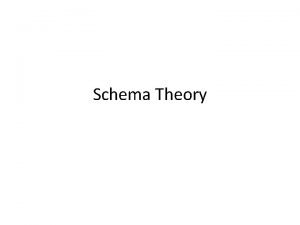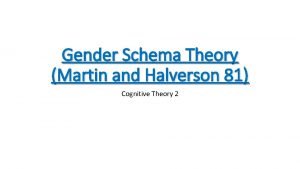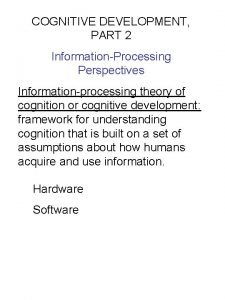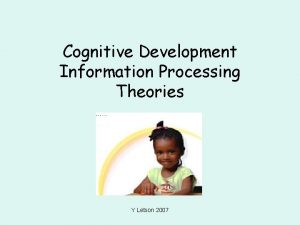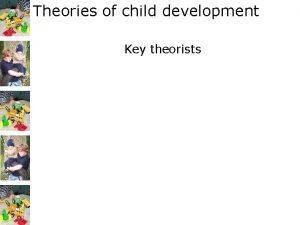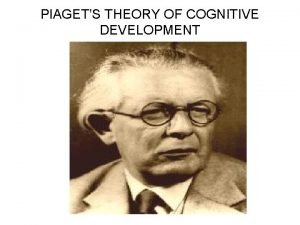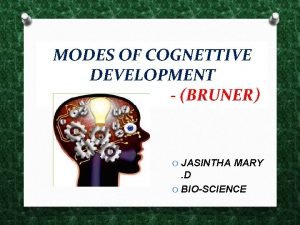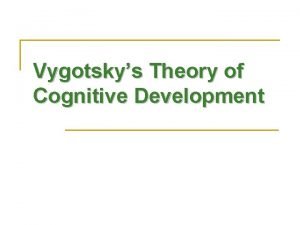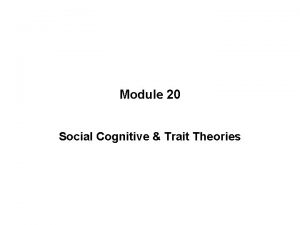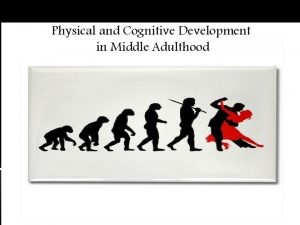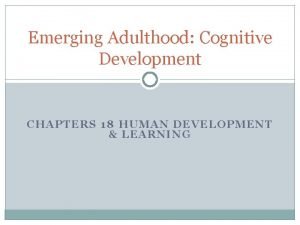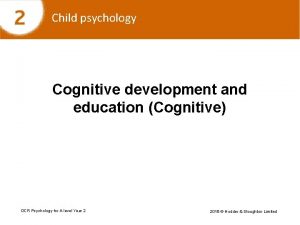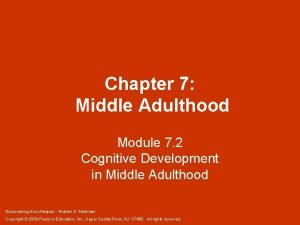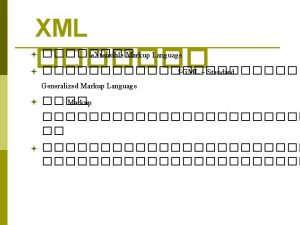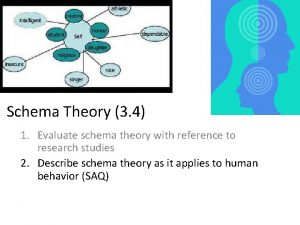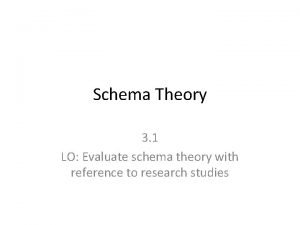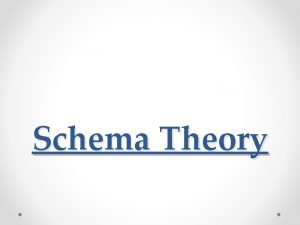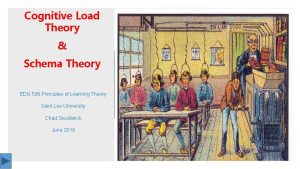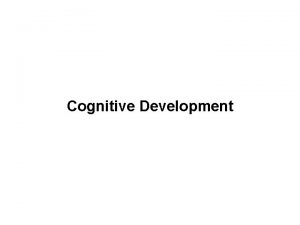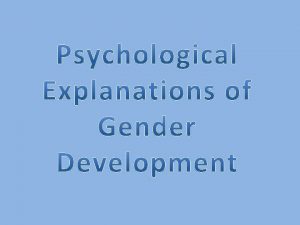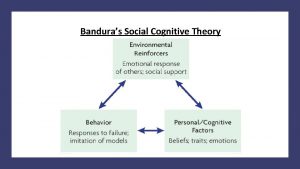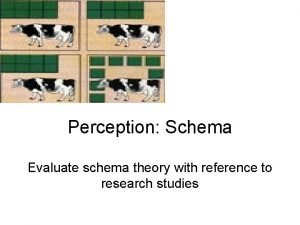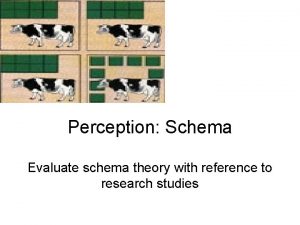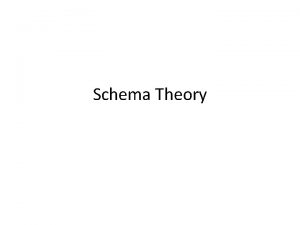GENDER SCHEMA THEORY Cognitive explanation of gender development







![In pairs… Describe and evaluate Kohlberg’s explanation of gender development. [16 marks] • Possible In pairs… Describe and evaluate Kohlberg’s explanation of gender development. [16 marks] • Possible](https://slidetodoc.com/presentation_image_h2/1acdbafe3c9f18542936cf43693d5458/image-8.jpg)

























- Slides: 33

GENDER SCHEMA THEORY Cognitive explanation of gender development

Gender consistency theory test: Quiz All questions are worth 1 mark unless otherwise stated. 1. Whose theory is it? 2. Which approach does theory come from? 3. Name three stages and put them in the correct order (3 marks) 4. When should children show gender appropriate behaviour? 5. The process of a child’s thinking about gender drives their gender socialisation. What is this process called?

Modal essays • Read through the modal essays individually • Highlight the different sections (A 01, A 02, A 03) • Annotate on the essay the strengths and weaknesses. • Using the mark scheme, what grade would you give the essay. You are the examiner • As a group, identify • Strengths and weaknesses • Final grade (mark out of 16)

Response C There is some knowledge of Kohlberg’s theory of gender development evident, although there is a lack of clarity in parts. For example it is not clear what is meant by ‘gender stability’ from the expansion – “if a child saw a woman in parts they’ll think it is a man”. There is an attempt to evaluate but this is only partly effective. For example, it is not explained why the point about nature/nurture is a strength; and there is no link back to the question with respect to cultural validity. The answer lacks clarity and the meaning is sometimes obscured by poor spelling. There is occasional inappropriate use of specialist terminology eg the first sentence of the last paragraph refers to ‘cognition’ but probably means ‘gender development’. This is a Level 2 answer – the description is largely accurate but lacks sufficient detail and the evaluation is only partly effective. There is a general lack of clarity and precision. Mark awarded = 6

Response A Knowledge of Kohlberg’s explanation of gender development is accurate and contains sufficient detail of the relevant stages. There is a slight inaccurate use of the term ‘self-socialism’ in paragraph 4, but the correct term ‘self-socialisation’ is used later. There is effective evaluative comment, with the points generally explained rather than simply stated. There is also appropriate selection and use of evidence to support Kohlberg (eg Slaby and Frey). The answer is clear and coherent with good use of paragraphing. Specialist terminology is used largely effectively throughout the answer (eg naming of the stages; qualitative nature of the stages; external validity; maturation etc. ) and the answer is succinct and focused. This is a Level 4 answer – it contains sufficient knowledge and effective discussion for this level. Mark awarded = 12

Response B Knowledge of Kohlberg’s theory is evident and the three stages are accurate although there is some detail lacking. For example, it is not explained that gender labelling means that a child recognises that s/he is male or female. The description includes some general information about theory eg being ‘cognitive’ and developing in ‘qualitatively different stages’. The evaluative points are fairly well explained with respect to theory and the points are therefore effective. The final point regarding underestimating children’s ability to understand gender would have been enhanced with some evidence to support the claim. The answer is coherent and succinct and uses specialist terminology reasonably effectively. This is a Level 3 answer – although the description and evaluation lack sufficient detail for the top level, the answer is well organised and the material is accurate with effective evaluation. Due to the brevity of the answer it is at the lower end of the mark allocation. Mark awarded = 9

Task: Improve the points from the responses you identified as weaknesses. • The second stage is gender stability this is where the child believes that gender is fixed across time and not situations. This occurs at the age of 5. For example if a child saw a women in parts they’ll think it’s a man. • A strength of this study is that it provides strength for nature and nurture…. • A further criticism of Kohlberg’s theory of gender development is that it is considered a good description of how gender develops but it does not offer any real explanation of how these processes occur.
![In pairs Describe and evaluate Kohlbergs explanation of gender development 16 marks Possible In pairs… Describe and evaluate Kohlberg’s explanation of gender development. [16 marks] • Possible](https://slidetodoc.com/presentation_image_h2/1acdbafe3c9f18542936cf43693d5458/image-8.jpg)
In pairs… Describe and evaluate Kohlberg’s explanation of gender development. [16 marks] • Possible content • Possible evaluation point Read through the research/ evaluation points. Select 3 evaluation points that you feel confident in using

GENDER SCHEMA THEORY

Gender schema theory • Martin and Halverson agree with Kohlberg that the child’s thinking is at the basis of their development of gender role behaviours • However, they argue that the process starts much earlier than Kohlberg suggested - children learn pre-programmed gender schema between age 2 -3

Question Do you make any automatic assumptions about people based on whether they are male or female to help you manage your everyday interactions?

Imagine… Imagine you are at a party and you meet a person for the first time. You really want to have fun and make a good impression. Would the person’s gender influence the way you approach the situation: how you behave, what you talk about, what you ask questions about, what you joke about etc. ?

Now imagine… Now imagine that you had to look after a friend’s 8 -year-old for the first time. You really want the child to have fun. Would the child’s gender influence the way you approach the situation: what activities you prepare, what you talk about, what you ask questions about, and so on?

Think about other everyday situations: going for a job interview, talking to the checkout clerk at a supermarket, meeting a new work colleague, etc. Try and list some of the inferences you make about people simply from knowing their gender.

Martin and Halverson At the core of theory is the notion of ‘schema’, a mental structure that guides the processing of information and experiences. Two key schemas are involved. The ‘in-group – out-group’ schema includes a broad categorisation of attributes, activities, and objects as being either for boys or for girls. In other words, boys and girls are said to have a mental representation of what is suitable for their in-group and what is appropriate for their out-group. the ‘own sex’ schema, involves more detailed information about those behaviours, traits, and objects that are considered to be characteristic of their in-group. As soon as children are able to label themselves as boys or girls, they will start to form these schemas in order to make sense of the world around them. It is not until children are a little older (around the age of 8) that they build more elaborate schemas for both genders

Comparison The basic proposition of Kohlberg (1966) still applies: “I am a boy, therefore I want to do boy things”. The difference is that the notion “I am a boy” need only reflect basic gender labelling, as opposed to a full appreciation of gender constancy. Once this understanding is present and the environment provides information about certain toys or activities as masculine or feminine (which is organised in the in-group – out-group schema), children will be driven to find out more about the in-group set of toys or activities. In this way, the in-group – out-group schema determines what information goes into the more detailed and elaborate own sex schema e. g. if a boy views an object or activity as masculine he will approach it, interact with it, and find out more about it. children are seen here as having internal, self-regulating standards as soon as they label themselves as boys or girls.

Gender Schema Theory • Children monitor their environment for information and behaviours that are consistent with their ideas of appropriate male and female behaviour and add or assimilate this information into their thinking. • If a behaviour is considered inconsistent they may just ignore it so that their stereotypes or schemas don’t need to be altered – they need to be able to predict behaviour and stereotypes allow them to do this.

Gender schema theory Gender schema An internal mental representation of the world which is used to make sense of experience Gender script An internal representation of a set of actions that make up a routine Once children have developed these gender schemas and scripts, they begin to pay more attention to activities associated with their own sex than the opposite sex Girls behaviour Girls play with dolls and dress up as princesses Boys play with cars and dress up as superheroes Future information consistent with gender schema? YES NO Failure to encode that information i. e. information rejected NO YES

Sandra Ben: Further explanation • Sandra Bem (1981) suggested that children can be categorised as gender-schematic (they perceive information about themselves that reflects stereotypes and are more ready to categorise behaviours as definitely male or female) or gender non-schematic (they have a more androgynous schema with both male and female behaviours). Androgyny is healthier as it allows for more flexible behaviour and less anxiety.

Quick fire questions 1. What is a schema? 2. What two schema’s are involved in the model proposed by Martin and Halverson (1981)? 3. When do children start to develop the schemas? 4. What's the difference between Kohlberg’s constancy theory and Martin and Halverson’s Gender schema theory?

Quick fire answers 1. What is a schema? A mental structure that guides the processing of information and experience 2. What two schema’s are involved in the model proposed by Martin and Halverson (1981)? In-group – out-group schema, ‘own sex’ schema 3. When do children start to develop the schemas? As soon as children are able to label themselves as boys or girls. What's the difference between Kohlberg’s constancy theory and Martin and Halverson’s Gender schema theory? Predict when children will begin to absorb gender-relevant knowledge. Kohlberg = Gender Constancy/ Martin and Halverson = Gender Identity, or as soon as the children have some awareness or which group they belong to. 4.

Activity Identify examples of the following terms in the paragraph below: identification of in group /Identification of out group / identification of own sex / sex-stereotypical behaviour Samina attends a day nursery. In the nursery there are lots of toys including a pink play house, a toy tool kit and a play kitchen. Samina doesn’t play with the tool kit because, as far as she is concerned, tools are for boys, and Samina knows that she is a girl. She believes that play houses and kitchens are girls’ toys. She spends a lot of her time at nursery in the playhouse and pretending to cook in the kitchen

Activity 1. How can gender schema theory explain a boy’s disruptive behaviour in the classroom, or a girl not trying at maths? 2. Application: How could gender role schemas be broken down by teachers

Evaluation Answer and expand on the below points: 1. Identify two pieces of research that support/refute GST 2. Does theory explain Individual differences? 3. Is theory explanatory? 4. Are there any practical applications we can take from theory? Can we relate any of the issues and debates to this approach?

Individual differences • weakness of the gender schema theory • not all children conform to gender stereotypical behaviour. For example, those who are raised as gender neutral • Furthermore, the gender schema theory has difficulty explaining why different children with much of the same environmental influences respond differently to genderappropriate behaviour. For example, this theory cannot explain why some girls may prefer action figures and some boys may prefer barbies. • What other explanation could we use to explain this?

Is theory explanatory? • Explanatory, rather than simply descriptive (a criticism of Kohlberg’s’ cognitive theory of gender development). • The gender schema theory offers a more detailed cognitive explanation of the process that underpins gender. • For example it offers a greater understanding as to why children have rigidity gender beliefs (children do not accept information that goes against their schema). • Although the gender schema theory does offer a more detailed and explanatory understanding of gender development compared to Kohlberg’s theory, there are still questions regarding gender development that aren’t answered by the cognitive explanation.

Practical applications? • A strength of the gender schema theory is that it can help explain some of the processes by which gender stereotypes become so psychologically ingrained in our society. • Understanding these processes has led to many practical applications, particularly in the area of education. • For example, it has helped raise awareness that the male/female dichotomy is used as an organising framework, often unnecessarily, especially in the school curriculum. • By knowing this and understanding student behaviour in the classroom it has helped educators promote gender equality (questioning, seating plans) and has helped to teach alternative schemata to children so they are less likely to build and maintain a gender schema

I&D: nature vs. nurture The gender schema theory suggests that we innately organise information in order to make sense of the world around us, children develop gender schemata for this reason. However this theory also suggests that gender schemata develop as a result of social and environmental factors thus emphasises the role of nurture in gender development. This provides a logical explanation for why gender stereotypes develop, and creates a more flexible way of explaining a child's understanding of gender than Kohlberg’s theory.

Activity Jessica is 6 years old and is talking to her mum about what she wants to do when she grows up. “I want to be a doctor because doctors are caring and kind”, says Jessica. “That’s nice”, says her mum, “and will you get married? ” “Yes I will”, replies Jessica, “and I will wear s beautiful pink wedding dress with a bow in my hair and carry pretty flowers. ” “Lovely”, says her mum, “and what will your husband wear? ” Jessica thinks for a minute and finally replies, “I don’t really know what boys wear at weddings. ” Use your knowledge of gender schema theory to explain the conversation between Jessica and her mum. Outline the psychology Link to Jessica

Activity Oli’s parents both go out to work. Oli’s mum likes doing DIY jobs at the weekend, like assembling flat pack furniture, and his dad never uses the power drills but prefers to read a book. However, when Oli is shown a drill and asked “who would use this, mummy or daddy? ”, he replies “Daddy”. And when he is asked what mummy and daddy do all day, he says “daddy goes to work and mummy cleans the house”. How does gender schema theory explain Oli’s answers? (6 marks)

Activity: Choose one question to answer. 1. Outline gender schema theory explanation of gender development (6 marks) 1. Give one criticism of the gender schema theory (4 marks) 2. Explain in what way gender schema theory is an example of 3. the cognitive approach in psychology. (3 marks) 4. Explain one difference between Kohlberg's theory of gender development and the gender schema theory. (4 marks)

Plan. In your groups. Complete the handout: comparing the two cognitive explanations Discuss the cognitive explanations into gender development (16 marks)

Extension: complete the additional handouts 1. research methods 2. Questions on cognitive explanations of gender 1. Which theory states children will start searching environment that encourages their knowledge of their gender at age 2 -3? 2. Which theory uses role models when children are 6+ so they can imitate them 3. Which theory can be criticised for using interviews to gather data with young children
 Cognitive development schema
Cognitive development schema Brewer and treyens
Brewer and treyens Martin and halverson (1983)
Martin and halverson (1983) Gavi ansara
Gavi ansara Gender schema theory
Gender schema theory Genderschema
Genderschema Schema theory evaluation
Schema theory evaluation Cognitive learning theory was presented by
Cognitive learning theory was presented by Robert siegler theory
Robert siegler theory Information processing theory of cognitive development
Information processing theory of cognitive development Information processing theory of cognitive development
Information processing theory of cognitive development What is gesell's theory of development
What is gesell's theory of development Conclusion of piaget's theory
Conclusion of piaget's theory Transductive reasoning psychology
Transductive reasoning psychology Piaget's preoperational stage
Piaget's preoperational stage Bruner's theory of cognitive development
Bruner's theory of cognitive development Information processing theory of dreams
Information processing theory of dreams Guided participation examples
Guided participation examples Piaget's theory of cognitive development
Piaget's theory of cognitive development Cognitive and non cognitive religious language
Cognitive and non cognitive religious language Trait theory vs social cognitive theory
Trait theory vs social cognitive theory Strategic gender needs and practical gender needs
Strategic gender needs and practical gender needs Intellectual development middle adulthood
Intellectual development middle adulthood Physical development in adulthood
Physical development in adulthood Late childhood cognitive development
Late childhood cognitive development Ap psych schema
Ap psych schema Late adulthood intellectual development
Late adulthood intellectual development Emerging adulthood cognitive development
Emerging adulthood cognitive development Cognitive levels of development
Cognitive levels of development Characteristics of cognitive development
Characteristics of cognitive development Cognitive development in education
Cognitive development in education Cognitive development middle adulthood
Cognitive development middle adulthood Cognitive development in adulthood
Cognitive development in adulthood Chapter 9 early childhood cognitive development
Chapter 9 early childhood cognitive development

